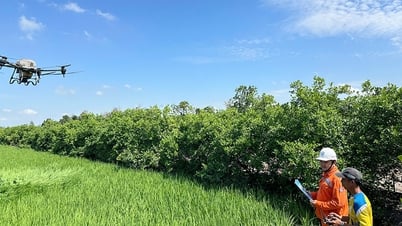TPO - The meteorological agency forecasts that in the coming days, hot weather will continue to persist in the Ho Chi Minh City area with increasing intensity.
According to the Southern Hydrometeorological Station, yesterday (March 15), heat waves appeared widely in the Eastern region, with the intensity of the heat increasing compared to the previous day.
The highest temperature ranges from 35-37 degrees, some places above 37 degrees such as Dong Xoai (Binh Phuoc) 37.2 degrees.
It is forecasted that during the weekend, widespread heat will continue to appear in the Eastern region and some places in the Southwest, with some places in the Eastern region experiencing intense heat above 37 degrees Celsius.
In the next 3-5 days, the heat will continue in the Southeast region and expand in the West.
 |
Ho Chi Minh City residents struggle under the heat. Photo: Duy Anh |
Today (March 15), Ho Chi Minh City has localized heat. The highest temperature at Tan Son Hoa station is 35 degrees.
It is forecasted that the hot weather will continue in Ho Chi Minh City over the weekend. The highest temperature will be from 35-37 degrees Celsius.
In the next 3-5 days, the heat will continue to persist in Ho Chi Minh City with increasing intensity.
“Hot weather combined with high ultraviolet (UV) index affects people’s health when participating in outdoor activities for a long time. Along with that, low humidity in the air, dry weather, need to be careful of fire and explosion” - Southern Hydrometeorological Station recommends.
Saltwater intrusion situation in Ho Chi Minh City
According to the Ho Chi Minh City Department of Irrigation, the salinity concentration surveyed in the second phase of March 2024 at stations on main rivers, canals and streams in the Ho Chi Minh City area was higher than the salinity concentration in the first phase of March 2024 (the previous period) but still lower than the salinity concentration in the third phase of March 2023 (the same period last year) and lower than the average maximum salinity in March for many years (TBNN).
In the second period of March 2024 (March 12-13, 2024), the salinity concentration increased compared to the first period of March 2024 - the previous period (February 3-4, 2024), the reason being that the second survey period of March 2024 coincided with the high tide period of the month (typically, at Phu An station on March 12, 2024, the high tide reached a peak of 1.61m, exceeding the alarm threshold III).
According to the Ho Chi Minh City Irrigation Department, the salinity concentration is penetrating deeper into the main rivers, in addition to the main cause being the influence of tidal currents, partly because it is currently the peak of the dry season, the weather is hot and dry, and at the same time, the reservoirs upstream have reduced the flow of water discharged downstream.
At Nha Be Cape and Ong Thin Bridge stations, the salinity concentration is higher than at the other stations because Nha Be Cape (Dong Nai River) and Ong Thin Bridge (Can Giuoc River) stations are both on the main rivers and close to the sea, so they are affected by tidal currents from the sea. The two stations of Xang - An Ha Canal and Rach Tra Bridge are deep in the fields, so they are less affected by tidal currents from the sea.
The highest salinity concentrations at specific stations are as follows: Nha Be cape (SMAX = 12.20 g/L), Cat Lai ferry (SMAX = 9.30 g/L), Ong Thin bridge (SMAX = 11.70 g/L), C canal - Cho Dem (SMAX = 6.30 g/L), Thu Thiem bridge (SMAX = 5.90 g/L), Xang canal - An Ha bridge (SMAX = 2.40 g/L) and Rach Tra bridge station (SMAX = 0.50 g/L).
According to the salinity statistics measured in the first quarter of 2024 at the survey stations, from January to March, the salinity at the survey locations on the main canals and streams tended to increase gradually, with the highest measured value in March and lower than the measured value in the same period in 2023. On the main rivers such as Nha Be River and Dong Nai River, the concentration tended to increase but was still lower than the average of many years.
Specifically, the highest salinity measured at Mui Nha Be station in March 2024 was 12.2‰, lower than the average maximum salinity of many years by 18.4‰, and at Ong Thin station, the maximum salinity measured in March 2024 was 11.7‰, lower than the average maximum salinity of many years by 13.47‰.






Source


![[Photo] Many people in Hanoi welcome Buddha's relics to Quan Su Pagoda](https://vphoto.vietnam.vn/thumb/1200x675/vietnam/resource/IMAGE/2025/5/13/3e93a7303e1d4d98b6a65e64be57e870)

![[Photo] President Luong Cuong attends the inauguration of the international container port in Hai Phong](https://vphoto.vietnam.vn/thumb/1200x675/vietnam/resource/IMAGE/2025/5/13/9544c01a03e241fdadb6f9708e1c0b65)
![[Photo] Prime Minister Pham Minh Chinh receives Ambassador of the French Republic to Vietnam Olivier Brochet](https://vphoto.vietnam.vn/thumb/1200x675/vietnam/resource/IMAGE/2025/5/13/f5441496fa4a456abf47c8c747d2fe92)
![[Photo] President Luong Cuong awarded the title "Heroic City" to Hai Phong city](https://vphoto.vietnam.vn/thumb/1200x675/vietnam/resource/IMAGE/2025/5/13/d1921aa358994c0f97435a490b3d5065)



























































































Comment (0)